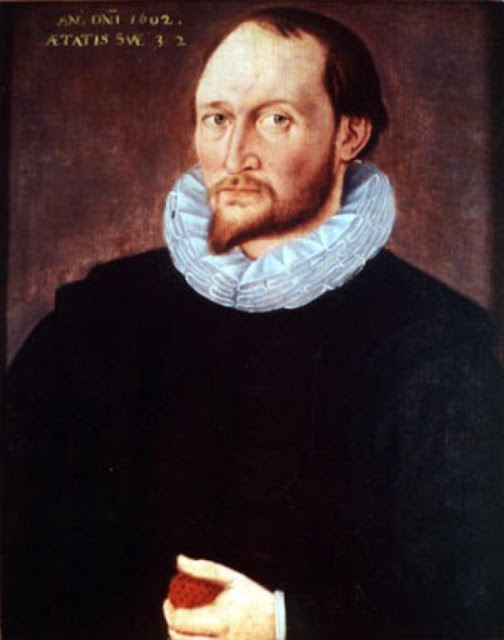Dr Mark Nicholls’s teaching and research
interests lie in Tudor and Stuart government and politics. He was the
co-author with Penry Williams of Sir Walter Raleigh: in life and legend,
published by Continuum in 2011.
He has published several analyses of
conspiracies and state trials, as well as studies of ‘succession politics’ at
the death of Queen Elizabeth I and the political career of Sir Walter Raleigh.
And yet, as he concluded in his lecture, ‘we know plenty but not enough’ about the Great Elizabethan; there remains ‘layer upon layer of complexity’. He remains ‘an astonishing man’.
And yet, as he concluded in his lecture, ‘we know plenty but not enough’ about the Great Elizabethan; there remains ‘layer upon layer of complexity’. He remains ‘an astonishing man’.
Oliver Cromwell, reputedly an admirer of the 'History of the World', although Dr Nicholls observed that 'Cromwell was not really a reading man, the Bible apart.’
Dr Nicholls in his lecture gave a masterly survey of the different phases of Raleigh’s life, revealing the contradictions. Such puzzles are evident even in the text of the History of the World, known to have been admired by Cromwell: passages which seem to support the divine right of kings are countered by those which take the opposite view.
In life, Raleigh himself can be seen as a
villain as well as a martyr, admitted Dr Nicholls. He was capable of ‘savagery’,
suffering from the ‘insecurities of the younger son’: there was ‘something of
the little boy about him’ with his tendency to exaggeration. By way of contrast
there was also a ‘black dog’ pessimism and cynicism.
Above: The DECLARATION OF THE DEMEANOR AND CARRIAGE OF SIR WALTER RALEIGH, Knight, as well in his Voyage, as in, sithence his Returne; And of the true motiuves and inducements which occasioned His Maiestie to Proceed in doing Iustice upon him, as hath bene done.
Yet it was as a Protestant hero that Sir Walter was portrayed in the pamphlet war which followed his execution in October 1618.
The above Government-issued publication justifying the execution and attacking Raleigh was rushed out soon after his death.

Raleigh's supporters responded. 'Vox Spiritus' or 'Sir Walter Raleigh’s Ghost’ was a handwritten pamphlet, pictured above, produced in 1620 to promote the ideals of the late Sir Walter, namely the mistrust of Catholicism and all things Spanish.


Raleigh's supporters responded. 'Vox Spiritus' or 'Sir Walter Raleigh’s Ghost’ was a handwritten pamphlet, pictured above, produced in 1620 to promote the ideals of the late Sir Walter, namely the mistrust of Catholicism and all things Spanish.

Sir Walter Raleigh, moments before his beheading in Old Palace Yard, Westminster.
British Museum Collection
Dr Nicholls presented a detailed analysis of Raleigh’s 45-minute speech on the scaffold, pointing out how he had been able to manipulate the feelings of the watching crowd. The Great Elizabethan no longer needed to flatter kings: the claim that Death was now ‘his sovereign’ would have clearly made an emotional impact on his contemporaries.
The statue of John Hampden, taken in Aylesbury town centre. The statue was commemorated in 1912
Image credit: Wikipedia
and KingDaveRa
Certainly, as we were reminded, the scene made a deep impression on republicans such as John Hampden who witnessed the event.
I was curious to see that the lecture’s opening
slide included religious scepticism as one of Raleigh’s characteristics.
Dr Nicholls was kind enough to reply in detail
to my emailed question.
‘Ralegh was not above teasing a clergyman,
trying to trick him into a circular argument,’ he pointed out,
referring to the dinner given by Deputy Lieutenant of Dorset Sir George
Trenchard in 1593 and Raleigh’s confrontation with Ralph
Ironside, a clergyman of Winterborne. ‘That was in character’.
‘But the accusations of atheism rest in part on his tendency for such mischief, in part on his patronage of 'scientific' men like Thomas Harriot, and in part on a hostile 'press'
before 1603 which seems to have been picked up on by Catholic authors on the continent, keen to exploit what they saw as divisions and weaknesses in the English court. Both he and Bess were, essentially, religious people. When it matters they turn to God, if not necessarily to Christ.’
Richard Cromwell, Lord Protector of the Commonwealth of England, Scotland and Ireland, but only for 264 days from 3 September 1658 to 25 May 1659
As for Cromwell’s view of Ralegh's History, and the fact that he had recommended it to his son Richard, Dr Nicholls has a slight reservation. ‘I think the recommendation came with the thought that here was a convenient big book on ancient history which could serve the boy well without the need for compiling a library. Cromwell was not really a reading man, the Bible apart.’
Dr Nicholls’ other publications include Investigating Gunpowder Plot (Manchester, 1991) and The History of the Modern British Isles, 1: The Two Kingdoms, 1529-1603 (Oxford, 1999) the first volume in the Blackwell History of Modern Britain series. He was closely involved in the conferences and public events marking the 400th anniversary of the Gunpowder Plot conspiracy in 2005.
He completed a new edition of George Percy’s Trewe Relacyon (2005), one of the key texts chronicling the initial English settlement at Jamestown, in Virginia. Having edited the Journal of the Society for Army Historical Research for eight years, he retains an active interest in the history and traditions of the British Army












No comments:
Post a Comment